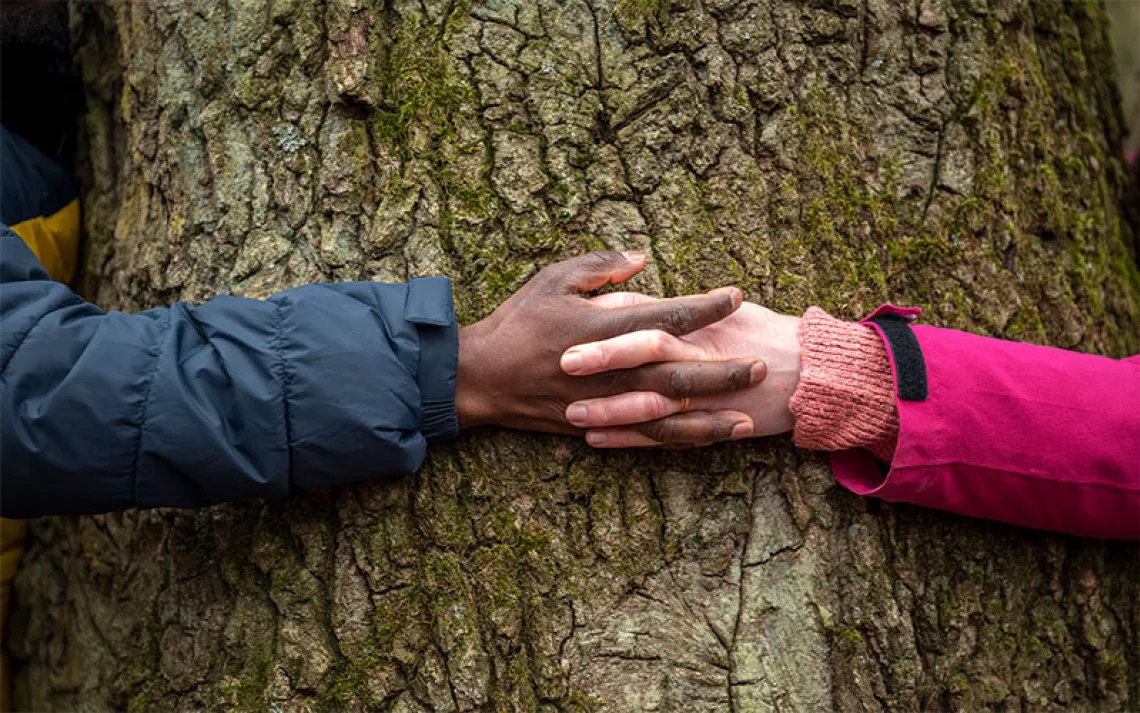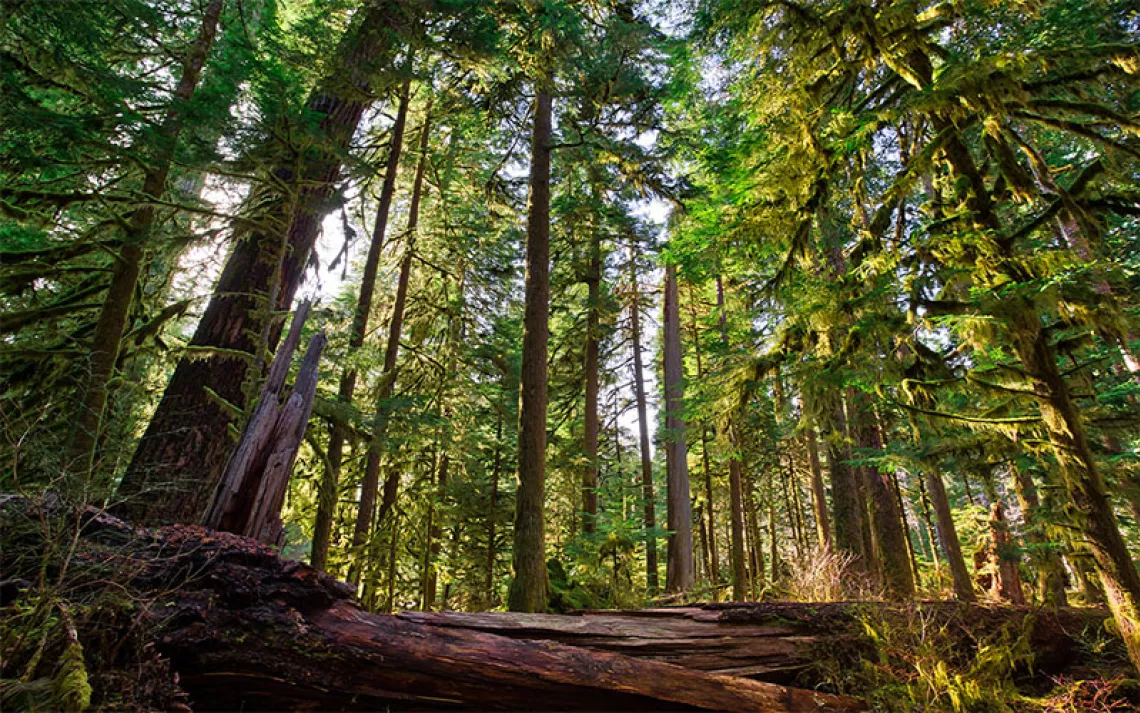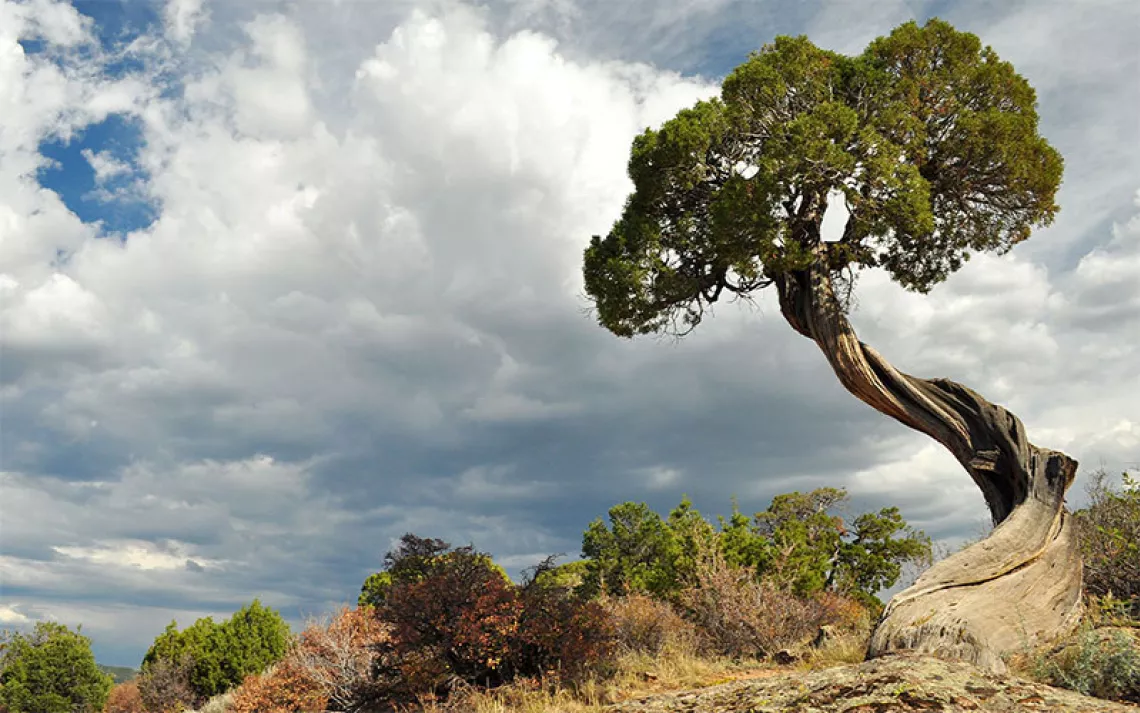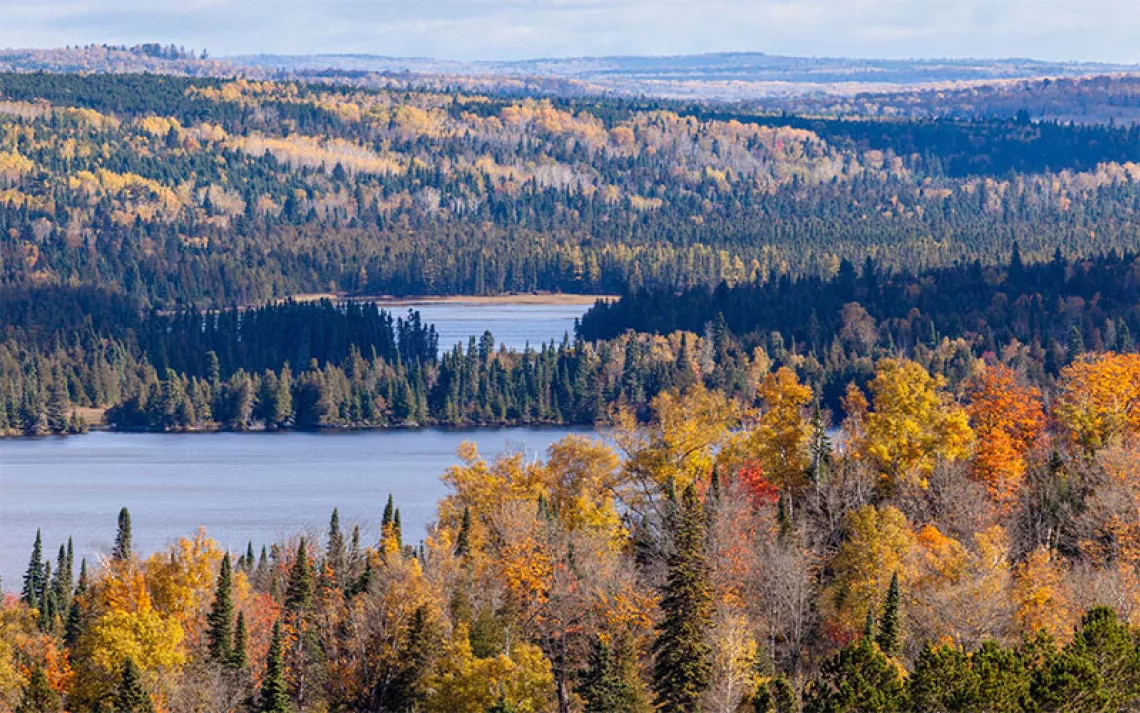Pirates of the Rainforest
The forests of the Olympic Peninsula have always been pillaged, and there's nothing law enforcement can do about it
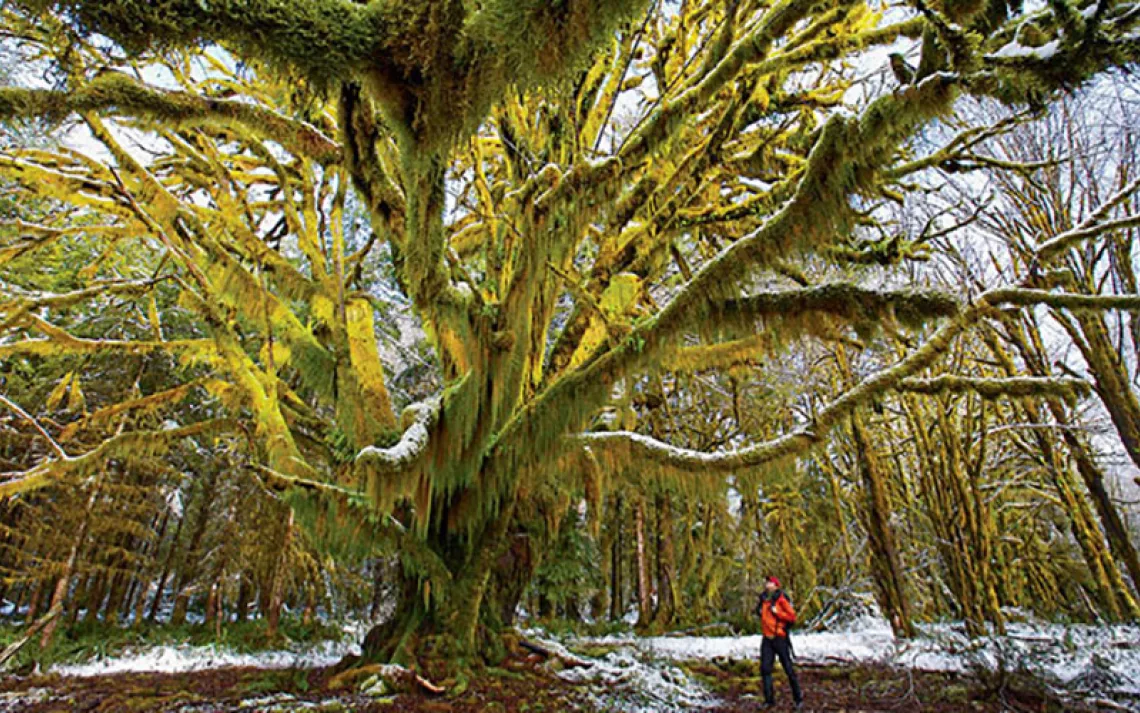
Olympic National Park naturalists keep the location of this ancient maple tree a secret because they fear poachers would strip it of its moss.
THE TRANSMISSION OF OUR AGING state-issue F-150 pickup wails in protest as we buck and roll along the U.S. Forest Service road. From the passenger seat, I squint at a dash-mounted GPS unit while Washington Department of Natural Resources enforcement officer Jared Eison steers around a Douglas fir limb jutting out onto the pocked gravel surface. "You hear that buzzing behind your seat?" he says. "It's the 140-watt linear kicking in to boost the radio signal. But we're too far out for that to help. This is a no-man's-land. No cellphone, no radio, no communications. I'm about the only guy, with the exception of Fish and Wildlife, who patrols this area."
Though I struggle to track our precise location, I know that we are close to the Queets River trailhead, the most isolated entry to Olympic National Park, which is the rainiest place in the Lower 48. Some 40 miles to the north is Forks, a formerly bustling logging outpost that's reinvented itself as a summer pilgrimage site for teenage tourists eager to witness the drizzly inspiration for Stephenie Meyer's Twilight series.
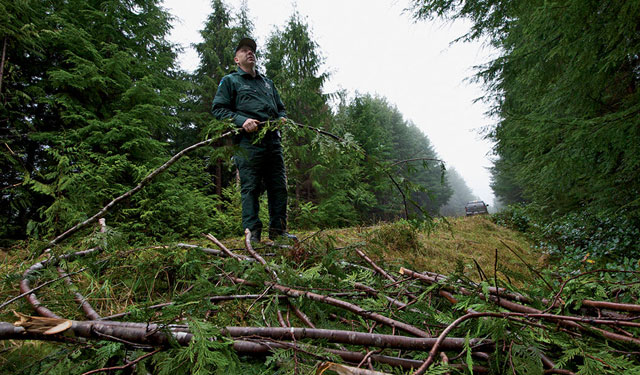
Officer Jared Eison, of Washington's Department of Natural Resources, discovers dozens of wPort Orford cedar pillaged for their boughs—one of many forest products in a flourishing black market.
Most visitors stay only long enough for a dayhike in Olympic National Park or a brief vampire tour. But another variety of visitor has come to this far corner of the Pacific Northwest to pillage its forest bounty: moss, salal, cascara, fir boughs, cedar shake, and other temperate rainforest plants, known collectively as "specialized forest products." As a result of strong demand from the European floral trade, these bouquet fillers have become a $350-million-per-year industry.
Carefully managed, this harvesting could have a small ecological footprint. But alongside the legal industry is a massive shadow operation of poachers, whose reckless extraction wreaks havoc on the forest and costs taxpayers millions.
What irks law enforcement most? It's damn near impossible to catch the bad guys.
OFFICER EISON PARKS HIS RIG on a lumpy pullout, rolls down his window, and inhales. "This is my office," he says. "It has a different view every day." The season's first snow has yet to fall, and the forest flaunts a psychedelic, disco-green winter palette. He gestures to the Remington 870 12-gauge and the Colt M4 semiautomatic in the gun rack between the seats. "The last time I called for backup, it took two hours and 45 minutes. So these are my two backups."
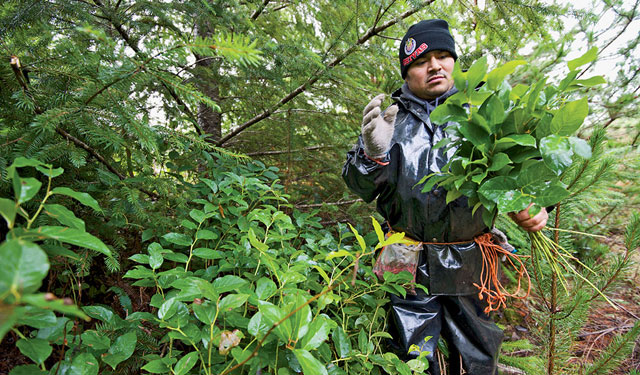
A licensed picker of salal from Oaxaca, Mexico. He works 8 to 10 hours a day and says he is paid very little for his efforts.
In these hinterlands, Eison has good reason to be packing heat. In 2008, his counterpart from the Forest Service, Officer Kristine Fairbanks, was murdered while investigating a suspicious vehicle on the north end of the Olympic Peninsula. While her killing wasn't related to the forest products trade, many illegal traffickers are armed and dangerous. A few years ago, Eison says, an illegal salal picker threatened him with a machete. "I had to pull my gun. He thought about it for a second and then took off running. I never did catch the guy."
Salal is a leafy shrub favored by Dutch florists, and the Olympic Peninsula is its prime territory. A 2002 memo in the files of the state's Department of Labor and Industries, acquired by the public-interest website Endgame Research, estimated that 27 million pounds of salal from this region were exported to Europe each year, with a sales value of more than $100 million. The state's Department of Natural Resources, private landowners, and packinghouses, called "brush sheds," issue permits validated by local sheriff's departments to legally harvest forest products, but many choose to forgo the $400 license. They bet that getting caught red-handed is unlikely—not unreasonably, considering that Eison's patrol area spans 357,000 acres and three counties.
Larry Raedel, the law enforcement chief of the Department of Natural Resources, makes frequent trips from the agency's Olympia headquarters to visit his eight officers in the 5.6 million acres for which they are responsible. "We're spread pretty thin," Raedel acknowledges. "We know there's a lot of theft happening out there and do all we can with what we have."
Given the government's limited enforcement resources, some landowners and brush sheds have resorted to deploying private contractors to patrol for poachers. Jim Furubotten is president of For-Con Services, a timberland security company based in Aberdeen with a long list of Pacific Northwest clients. His office is strewn with Ansel Adams prints, night-vision cameras, mercury-trigger switches, military-grade connection cables, and merchandising placards from a backpacking and mountaineering gear store he used to own. "In the old days, I'd just grab my pack and hit the mountains when I wasn't working," he says. "These specialized forest products used to just be the weeds and branches we tripped over while hiking through the woods. Now it's bigger money than you can imagine."
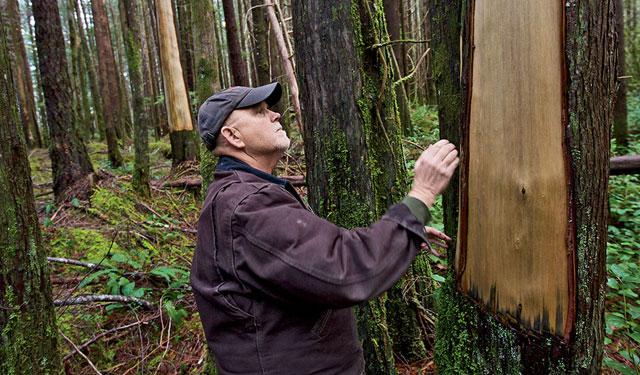
Jim Furubotten examines a cedar to see whether its bark has been illegally stripped by poachers.
To see it, Furubotten says, all you have to do is "hide your truck on a quiet spot out there and wait. All of the sudden the sides of the roads just come alive with the shadows and the sounds of brush being pulled to the roadside. It's a little freaky if you've never seen it before."
THE BIG BRUSH SHEDS on the Olympic Peninsula lease land from the Forest Service or timber companies and buy forest products from pickers with permits. The greenery is then sold to floral wholesalers and distributors. Legitimate sheds harvest in natural cycles: Salal, for example, can be sustainably gathered if patches are rotated every three to five years. Poachers, though, have no compunction about overpicking or off-season harvesting, which can kill off patches altogether. Their illicit goods are usually sold to mobile buying sheds, "basically some sort of U-Haul truck parked in a driveway or in front of a run-down motel room," Officer Eison says. "You shut them down one day and they pop up somewhere else the next."
One group suffering from the rapacious harvesting is the Quinault tribe, whose reservation lies southwest of the national park. James Smith, a Native American who worked as a resource protection officer on the Quinault Reservation through 2010, says that quality bear grass for traditional basket weaving can no longer be found. "Illegal harvesters are pulling it up by the root, snipping what they want, and leaving the rest to die," he says. "We've caught them out there killing 40 to 80 acres at a time per season." Ten million pounds of bear grass is exported from Washington to Europe annually.
In 2010, an elk hunter stumbled upon poachers taking 40,000 pounds of western white pine boughs for holiday wreaths—destroying two multi-acre stands of trees in the process. Legitimate harvesters encourage tree growth by leaving 30 percent of the upper-crown boughs uncut. But these poachers took all the branches, killing the trees.
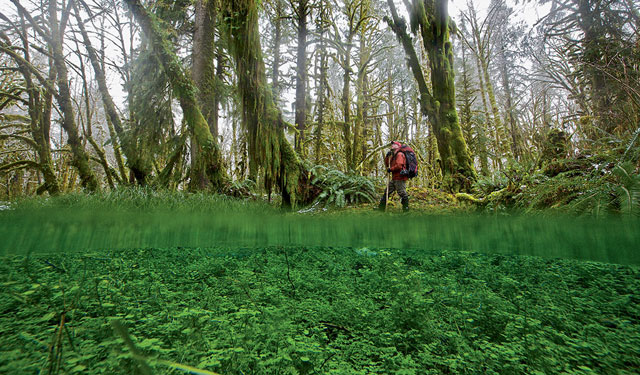
A backpacker on the Maple Glade Trail in the Quinault Valley passes a freshwater pool; the vegetation is as lush below as above.
Scientists still know very little about rainforest moss ecosystems, says Robin Wall Kimmerer, author of Gathering Moss. "Mosses of the Pacific Northwest are like coral reefs of the forest," she says. "The biodiversity is incredible." When mosses are stripped from the ecosystem, they can take decades to come back—along with the microorganisms and invertebrates they shelter. "There is such a thing as old-growth moss," she says. The amount of moss harvested from the Pacific Northwest and sold to the floral industry annually, usually as soil cover for potted plants, could be in the tens of millions of pounds.
In addition to its environmental impact, poaching also exploits its laborers, many of whom are undocumented immigrants. "These people are dropped off with a can of tuna and bottle of Gatorade for the entire day," says the Department of Natural Resources' Raedel. "We assume there are young kids not getting enough to eat and working long hours." In another 2002 memo acquired by Endgame Research, Washington's labor department estimated that out of 3,000 salal and bear grass harvesters in the state, "realistically, less than 100 are covered" by state labor regulations.
Last May, 43-year-old migrant brush picker Benjamin Roldan Salinas was stopped by a Forest Service officer while transporting salal near Forks, where he'd lived for 12 years. After the officer called Border Patrol for translation assistance, Salinas fled, attempting to escape by jumping into the frigid Sol Duc River. A search party discovered his body downstream three weeks later. "We typically just want to do our job, confiscate the product, issue the appropriate citation, and move on," says Clallam County sheriff's sergeant Brian King. "But the challenge is that many brush pickers are of questionable immigration status and can't discern between the police, Department of Natural Resources, Forest Service, and Border Patrol agents working in the area."
Most are willing to pay a citation but want to avoid Border Patrol.
In the Queets Valley, Officer Eison ticks off the clues he uses to find thieves: "I'm watching the puddles to see if they're clear or dirty. If they're dirty in the winter, after hunting season, then someone might be out here stealing. I look at the sheen of tire tracks to get a sense of direction."
That Doug fir limb we dodged up the road? It turns out it isn't windfall; it's a directional marker. The smoothly cut base, likely from a machete blade, is what gives it away. Hundreds of similar branches are scattered throughout the valley's road network to tell van drivers where to retrieve their salal pickers.
Eison guesses this is a poacher's marker. "There's plenty of A-grade product along the roadside he would have harvested if he had a permit," he says. "This guy made an effort to get off the road and hide." He searches the area and quickly finds footprints leading to a poaching site out of view of the road, fresh cargo-van tire tracks, taco sauce packets, gloves adorned with duct tape used to mount razor blades, and rubber bands for tying salal bundles into one-pound "hands." Each hand sells for 60 cents. A good picker can harvest 100 hands per day.
A short way down the road, we stop again, guided by another fallen branch, this one placed to conceal a small gap in the shrubbery along the road's edge. Eison clears the limb out of the way and picks up a trail marked by machete blaze. The gashes lead to a stand of noble firs that have been stripped of their branches for holiday wreaths. Eison sniffs. "Smells like Christmas," he says.
Over the next six hours, we find hundreds of western white pines pillaged for their boughs, a devastated lowland bear grass zone, and a handful of suspect salal harvests. Further investigation might well have led to another kind of forest-product operation, like the 2,200-plant marijuana grow that was discovered in the Queets in 2008. The site was fitted with three-quarters of a mile of irrigation pipe and littered with herbicides so toxic they are illegal in the United States. Many marijuana grows are found in areas from which salal and cedar have recently been harvested, Eison says.
"These guys can easily scout out the best areas and get them prepared for spring, when the grow season starts."
A few weeks later, I'm at the tail end of another ride-along patrol, with private security contractor Furubotten, when he locks eyes with the driver of a large box van on the outskirts of Hoquim. "Something's not right with that guy," Furubotten says.
Poachers are familiar with his vehicles, and sure enough, the van cuts a hard U-turn. After a brief deliberation, Furubotten gives chase. We catch sight of the van backing into a hiding spot behind a home 50 yards off the road. Incredibly, by the time we pull over and walk down the driveway, the van has vanished. There's a shed full of boxed floral greens at the end of the cul-de-sac. As two people duck into the home's back doorway, a cross-armed man shuffles over to take a position near the garage door.
"Have you seen a large van around here?" Furubotten asks.
"I didn't see anything," the man says.
We walk back down the drive. "That guy could have had anything in there," Furubotten muses. But he is out of his jurisdiction, and nobody is talking.
 The Magazine of The Sierra Club
The Magazine of The Sierra Club
